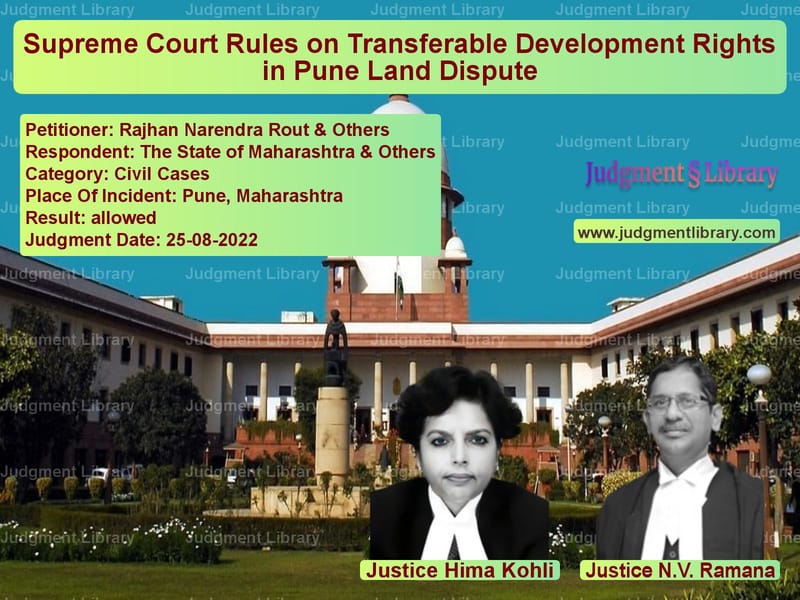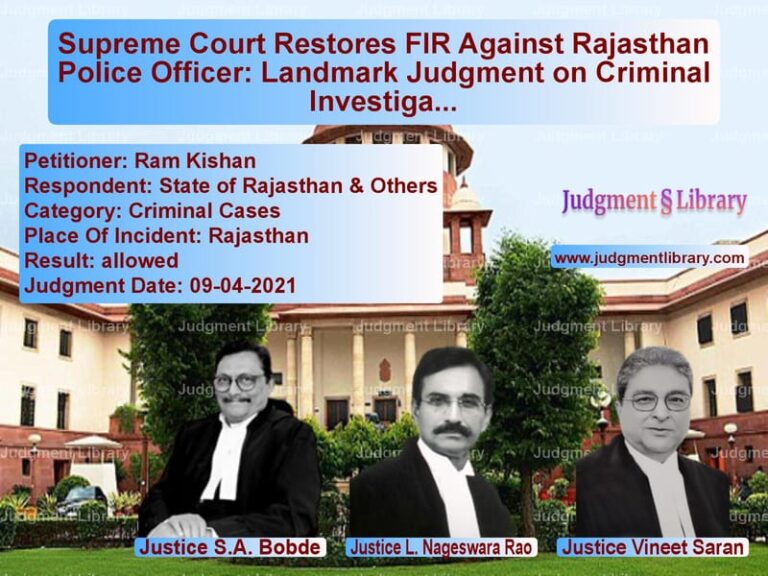Supreme Court Rules on Transferable Development Rights in Pune Land Dispute
The Supreme Court of India, in its landmark judgment in Rajhan Narendra Rout & Others v. The State of Maharashtra & Others, addressed the contentious issue of Transferable Development Rights (TDR) and Floor Space Index (FSI) granted for land acquisition under the Maharashtra Regional Town Planning Act, 1996. The case revolved around whether the appellants, who had surrendered their land to the Pune Municipal Corporation (PMC) for public purposes, were entitled to TDR at 100% FSI or merely 4% FSI.
Background of the Case
The dispute concerned a parcel of land located at plot No. 517 (part) and plot No. 523 (part) in Parvati, Pune, measuring 66,372.82 square meters. Under the Pune City Development Plan of 1987, this land was reserved for a park. The appellants surrendered the land to PMC, expecting compensation in the form of TDR, as provided under Section 126 of the Maharashtra Regional Town Planning Act. PMC initially granted TDR at 100% FSI but later reduced it to 4% FSI following a decision by the Chief Minister of Maharashtra in 2007.
Petitioner’s Arguments
The appellants, led by Senior Advocate Neeraj Kishan Kaul, contended the following:
- The reduction of TDR from 100% to 4% FSI was arbitrary and violated the doctrine of promissory estoppel.
- The Development Control Regulations (DCR) applicable to Pune did not designate the land as ‘Hill Top/Hill Slope,’ contrary to the State’s claims.
- PMC had itself sought legal clarification on TDR rates, and based on the Advocate General’s opinion, 100% FSI was granted.
- The appellants had relied on the government’s promise and surrendered the land in 2004, making it unjust to alter the TDR rate retroactively.
- For 18 years, the appellants had been deprived of land use and any compensation.
Respondents’ Arguments
The State of Maharashtra and PMC countered these claims with the following arguments:
- The original decision to grant 100% FSI was based on incorrect zoning information.
- PMC later discovered that the land fell within the ‘Hill Top/Hill Slope’ zone, where the permissible TDR was only 4% FSI.
- The appellants could not claim parity with residentially zoned land, as their land was meant for public use.
- Reversing the TDR reduction would set a precedent affecting future acquisitions and strain civic infrastructure.
Supreme Court’s Key Observations
The Supreme Court made several critical observations:
- The State of Maharashtra and PMC had inconsistently applied zoning regulations to the disputed land.
- The government had assured the appellants of 100% FSI at the time of land surrender, and later reneging on this promise was legally and morally unjustified.
- PMC’s argument regarding infrastructure strain was not a valid justification for depriving landowners of their due compensation.
- The procedural delays and indecisiveness of the State authorities had caused severe financial and legal hardships for the appellants.
Supreme Court’s Judgment
The Supreme Court ruled in favor of the appellants, issuing the following directives:
- PMC must return the land to the appellants within four weeks if it is not utilized for the intended public purpose.
- If PMC retains the land, it must compensate the appellants with Rs. 1 crore per year for the delay since 2004.
- The compensation process must be completed within three months.
- The impugned judgment of the Bombay High Court upholding the TDR reduction was quashed.
Impact of the Judgment
This ruling has significant implications for urban development and land acquisition laws:
- Protection of Property Owners’ Rights: The judgment affirms that landowners who surrender property for public use must receive fair compensation.
- Limitations on Arbitrary Government Decisions: The ruling prevents authorities from retroactively changing compensation terms after land has been acquired.
- Clarification on TDR Allocation: It establishes that Development Plans and zoning classifications must be consistently applied to avoid disputes.
- Accountability of Municipal Authorities: PMC and similar bodies must ensure transparent and fair implementation of urban planning regulations.
Conclusion
The Supreme Court’s decision in Rajhan Narendra Rout & Others v. The State of Maharashtra & Others provides crucial clarity on the application of TDR policies in urban land acquisitions. By reinforcing legal principles of fairness and accountability, the ruling ensures that government authorities cannot unilaterally alter compensation terms, thereby protecting the rights of landowners.
Read also: https://judgmentlibrary.com/supreme-court-dismisses-review-petition-in-property-dispute-case/
This case serves as a precedent for future disputes concerning land acquisitions and TDR allocation, reaffirming that procedural fairness and legal consistency are essential in urban development projects.
Petitioner Name: Rajhan Narendra Rout & Others.Respondent Name: The State of Maharashtra & Others.Judgment By: Justice Hima Kohli, Justice N.V. Ramana.Place Of Incident: Pune, Maharashtra.Judgment Date: 25-08-2022.
Don’t miss out on the full details! Download the complete judgment in PDF format below and gain valuable insights instantly!
Download Judgment: rajhan-narendra-rout-vs-the-state-of-maharas-supreme-court-of-india-judgment-dated-25-08-2022.pdf
Directly Download Judgment: Directly download this Judgment
See all petitions in Property Disputes
See all petitions in Damages and Compensation
See all petitions in Contract Disputes
See all petitions in Judgment by Hima Kohli
See all petitions in Judgment by N.V. Ramana
See all petitions in allowed
See all petitions in supreme court of India judgments August 2022
See all petitions in 2022 judgments
See all posts in Civil Cases Category
See all allowed petitions in Civil Cases Category
See all Dismissed petitions in Civil Cases Category
See all partially allowed petitions in Civil Cases Category







